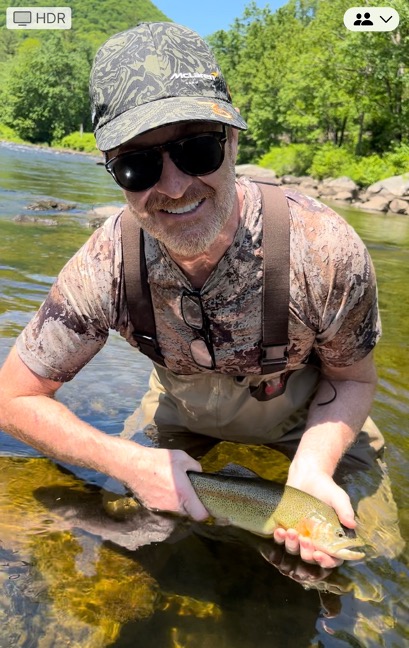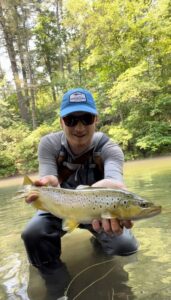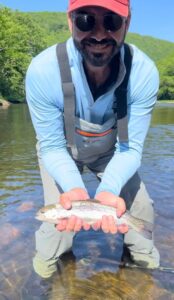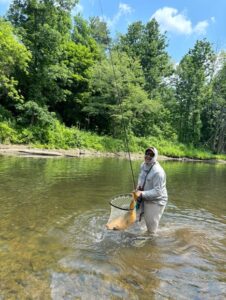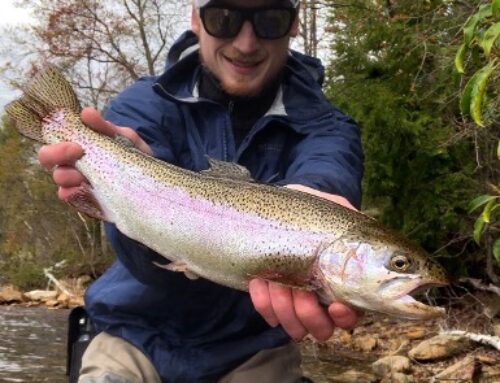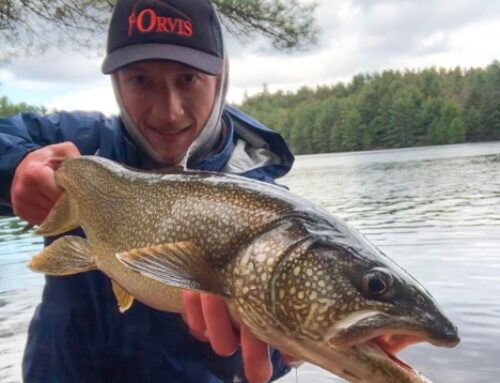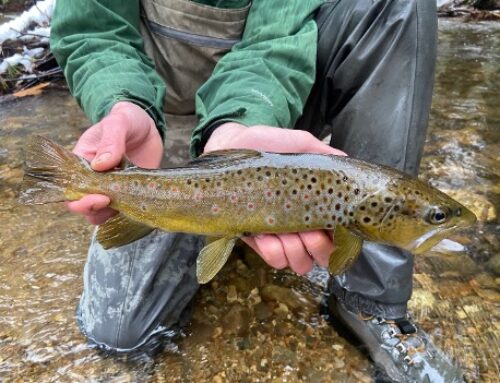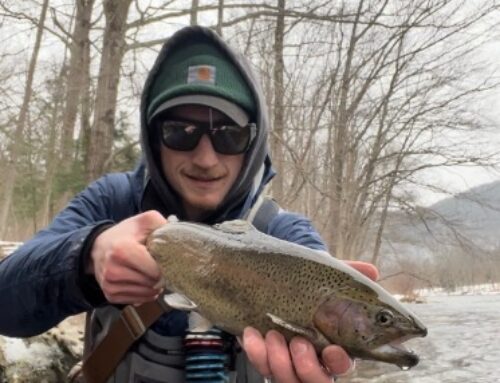Happy Fourth of July! Hope you all can get out there this long weekend.
Summer has arrived in a hurry with some scorching temps over the last couple weeks, leaving many local waters unseasonably warm. There’s still plenty of solid options out there, but there are also some important considerations to keep in mind when you’re heading out right now.
First and foremost, be aware of water temperatures while fishing for trout on most of the area’s larger rivers. Temps as high as 75° have been recently observed on the Deerfield, Westfield, and Millers rivers, well over the 68° mark when it’s still safe to fish for trout. Over that, fish mortality rates dramatically increase as fish struggle to recover after hard fights even with proper catch and release practices. A water thermometer is an essential piece of gear to be carrying right now and should be used to check temperatures everywhere one hopes to fish for trout. Thermometers can be found in both analog and digital models, both of which we carry at the shop.
There are of course a few tactics to keep in mind as one attempts to navigate away from warm water. Perhaps the best option is to fish during low light periods when temperatures can often be significantly cooler than in the heat of the day. Mornings are usually best when water is at its coolest, however, evenings can offer safe temperatures depending on where on the river you’re fishing. Often times, the higher upstream you go on any given watershed, the cooler the water will be. Consider fishing areas immediately below dams where the coldest water is released and headwater/feeder streams which are sourced by colder flows running down from elevation. Avoid slow and stagnant water which will generally be the warmest of all areas. In some situations, you may not be able to safely fish for trout altogether if you intend to release the fish and it’s important for the health of the fishery to lay off of them in such circumstances.
When water temperatures are ideal, fly selection hasn’t been too complex as the significant hatches of caddis, march browns, sulphurs and the like which we were seeing in May and June have slowed down considerably. All-purpose bugs like parachutes, klinkhammers, elk hair & CDC-wing duns, etc. are smart options for mayfly imitation. On the caddis side of things, you can never go wrong with a laundry list of elk hair variants: X-caddis, double wing, missing link, Goddard caddis, etc. are all good options to name a few. In flatter and slower water, consider throwing small CDC and poly-wing emergers which do an excellent job of converting fish even when they have time to get a good look at your presentation.
Also keep in mind that we’ve entered the season for both stonefly and terrestrial hatches. For stones, you can’t go wrong with stimulators and humpies, however, many patterns in the stonefly arena will do double duty for terrestrial imitations and vice versa. Chubby Chernobyls, PMXs, stimulators and the like will all do well in this regard. Remember that stoneflies and terrestrial bugs don’t hatch from the surface so are usually crash landing when coming in contact with the water. Often if you slap such flies down with some gusto, willing fish will take aggressively regardless of how many rubber legs your presentation has.
Whatever you’re throwing, remember that this is that glorious time of year when the dry-dropper rig can all but replace indicator fishing. Dry droppers are great when there aren’t many fish rising, when prospecting new water, and when trying to decipher where in the water column fish are feeding. In slower and/or more technical water, small nymphs—both weighted and standard—can be productively dropped off buoyant dry flies like parachutes. In more turbulent water, larger/heavier nymphs like a Pat’s rubber legs can be trailed under a high floating fly like the chubby Chernobyl, a local favorite-rig. Just like fishing an indicator, adjust dropper length and weight for depth and where in the column fish are feeding, and remember that your “indicator” always has a shot at eliciting an eat itself.
Elsewhere, the Swift River has finally returned to normal flows with a rate of 43 CFS as this report is being written. Remember that the Swift remains permanently cold even on the hottest summer days and is a phenomenal alternative when water is too warm to fish trout on the Deerfield, Westfield, Millers etc. The Swift supports a robust sulphur hatch which is still going relatively strong—considering how much the river has fluctuated this season—and on the best days, offers some of the best dry fly fishing for miles around. Swift sulphurs tend to be small, usually averaging about #18 with the largest at #16, and are best fished with small parachutes, sparkle duns, and the like. These gorgeous yellow-orange mayflies tend to pull the river’s larger brown trout to surface, so keep eyes peeled for rising kypes.
When prospecting and/or rises are scarce, think about throwing a dry-dropper and—purists, shield your eyes—don’t be afraid to get junky. Like it or not, eggs, worms, leeches, hot-spot nymphs, etc. are simply too popular among the Swift’s largely stocked trout population to leave out of the box. Small nymphs in sizes #18-#24 like zebra midges, pheasant tail variants, hare’s ears, etc. can be used as droppers instead, but don’t underestimate the power of the junk fly on the Swift.
Another great option for avoiding warm water while targeting trout is small water. Creeks tend to source from shaded elevation which maintains safe water temperatures in many cases. Fly selection is rarely all that important when creek fishing, so we recommend fishing a durable, high floating dry that can take the punishment of lots of eats, a common happenstance in small water. Fish often have little time to catch up to flies in the confines of creeks, so dry droppers can be extremely productive both to slow rigs down a bit in fast pockets and punch down into areas that hold fish but might make it tough for them to rise. In any case, make sure you’re still checking water temperatures as creeks can also get too warm to fish, especially when it hasn’t rained in a while.
Aside from trout is the all-too-often overlooked option of bass fishing. The Deerfield supports a productive smallmouth fishery all the way up to the Buckland dam (#4) and the Millers supports ample opportunity for smallies throughout most of its course. The Connecticut River is king among local smallmouth rivers and while it can be tricky to access, the payoff on the big river can be significant. These fiercely aggressive and hard fighting fish will take just about anything from a streamer to a topwater bug, even large nymphs and just about anything in between. Arguably the most exciting bite is topwater so we recommend starting with a popper, slider, deer hair bug, etc. and getting lower in the column from there as needed. And don’t forget about the area’s smallmouth-supporting lakes like Quabbin, Wachusett, and Onota. While they can be tricky to fly fish and sometimes require a boat to access, the biggest smallies in the state are undoubtedly confined in these larger still water fisheries.
As for largemouth, the regimen is relatively simple. Unlike smallmouth, largies are relatively lazy and spend most of their time meandering around the same structured areas. This fact is doubly true in summer when they tend to hug close to shaded structure, especially when the sun is high. Focus attention around lily pads, grass lines, wood piles and other areas of of solid structure that offer both cover and points of ambush. Willing eaters and found in just about any local still water, largemouth are a great summertime target for everyone from beginners to experts.
Hot summer days are a great time to target carp as well. While these fish are generally not super selective as far as flies go, they will put your presentation skills to the ultimate test. These are spooky beasts foraging in skinny water. You can find them in shallow mud flats of big rivers like the Connecticut and some ponds and lakes as well. Carpnasty and Hybrid Carp flies are a good place to start, but remember presentation is everything. You want your weighted fly to land softly near, but not on top of, slowly cruising or tailing fish. You may have to move it slightly to get the fish’s attention but once they are approaching it’s best to let the fly sit. If they do eat, hang on. These are powerful fish. Reece the kid is generally at the shop on Sundays and if you follow his social media, you already know that he gets it done with the carp in a big way.
Off the water, our convenience kiosk located in the Zoar Outdoor Adventure retail shop along Rt. 2 in Charlemont is stocked and opened for business. The space carries a solid selection of essentials for fishing the upper Deerfield and beyond, make sure to stop in next time you’re up that way. We’ll also be holding another free beginner’s casting clinic on July 24. And our second women’s retreat of the year with Cynthia Harkness is Sept. 13-14. As always, thank you for your continued support from all of us here at Deerfield Fly and we wish you luck next time you’re on the water.


